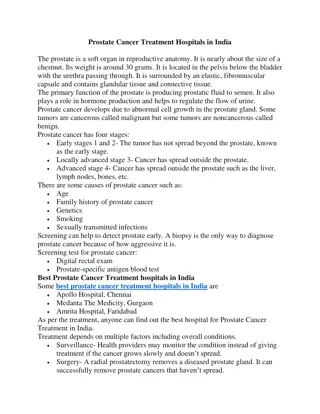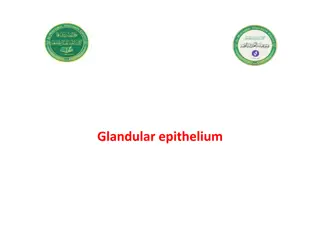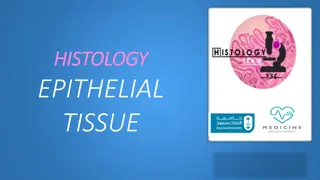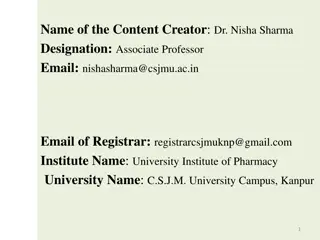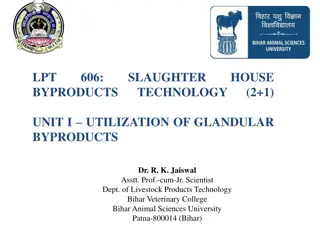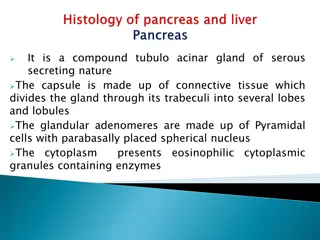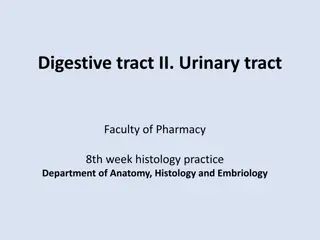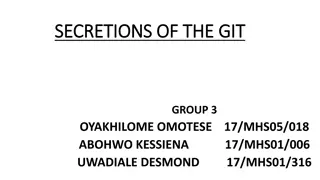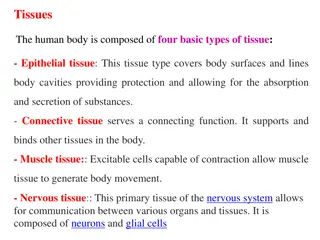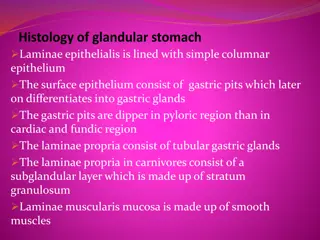Best Prostate Cancer Treatment Hospitals in India
The prostate is a soft organ in reproductive anatomy. It is nearly about the size of a chestnut. Its weight is around 30 grams. It is located in the pelvis below the bladder with the urethra passing through. It is surrounded by an elastic, fibromuscular capsule and contains glandular tissue and conn
1 views • 2 slides
Understanding Glandular Specialized Epithelium and Glands
Glandular specialized epithelium forms a class of epithelial tissues with specific functions and structures, composed of cuboidal, columnar, and ciliated columnar epithelial cells. These tissues contain gland cells that are secretary in nature, with zymogen granules in the cytoplasm. Glands are spec
1 views • 35 slides
Understanding Glandular Epithelium and Secretory Cells
Glandular epithelium consists of epithelial cells specialized in producing and secreting various macromolecules, found in glands throughout the body. These secretory cells can synthesize proteins, lipids, and carbohydrates, with different types of glands such as exocrine and endocrine glands. The se
0 views • 13 slides
Understanding Epithelial Tissue: Characteristics, Types, and Functions
Epithelial tissue is a crucial component of the body forming protective barriers, aiding in secretion, absorption, excretion, and more. Learn about its general characteristics, different types such as simple and stratified epithelium, glandular epithelium classification, and clinical applications li
0 views • 12 slides
Understanding Resins in Pharmacognosy: Properties and Occurrence
Resins are solid or semi-solid amorphous products rich in carbon atoms, found in plants, animals, and fossils. They contain essential oils, terpenes, and carboxylic acids. Resins have unique chemical and physical properties and are secreted in specialized structures like resin cells and glandular ha
0 views • 11 slides
Utilization of Glandular By-Products in Slaughter Technology
Animal glands, rich in healing substances, are valuable by-products in the pharmaceutical industry. This article emphasizes the overlooked potential for utilizing glands in India, focusing on collection and preservation methods to maintain the efficacy of hormones and enzymes extracted for medicinal
0 views • 22 slides
Structure and Function of a Serous Compound Tubulo-acinar Gland
A detailed description of a compound tubulo-acinar gland with serous-secreting nature is provided, highlighting its cellular composition, arrangement of ducts, and connective tissue organization. The glandular structure, including adenomeres, centroacinar cells, and myoepithelial cells, is discussed
0 views • 15 slides
Histology Overview of Digestive and Urinary Tracts in Pharmacy Practice
This histology practice session delves into the intricate details of the digestive and urinary tracts studied in the 8th week of Pharmacy school. Explore images showcasing the structures of the colon, vermiform appendix, liver, pancreas, and nephron. Gain insights into the histological features of t
0 views • 19 slides
Understanding the Secretions of the Gastrointestinal Tract (GIT)
The gastrointestinal tract (GIT) is responsible for digestion, absorption, and secretion through various glands along the alimentary canal. Secretions are stimulated by factors like direct contact, nervous system activation, and hormonal regulation. Hormones released in response to food presence hel
0 views • 7 slides
Understanding Epithelial Tissues: Structure and Function
Epithelial tissues play crucial roles in the human body, covering surfaces, lining cavities, and forming glands. They are highly cellular and rest on a basement membrane, separating them from connective tissues. Epithelial tissues serve functions such as protection, absorption, secretion, and contra
0 views • 15 slides
Structure of Gastric Mucosa in Glandular Stomach
The glandular stomach features laminae epithelialis lined with simple columnar epithelium, leading to differentiation into gastric pits and glands. The laminae propria houses tubular gastric glands, while the laminae muscularis mucosa is composed of smooth muscles. Different regions exhibit distinct
0 views • 14 slides
Perianal Suppuration: Abscess & Fistula Overview
Anorectal suppuration can lead to acute anal sepsis (abscess) or chronic anal fistula. This condition involves glandular secretions, infection, and suppuration, often originating from cryptoglandular sources. It can be caused by various specific conditions like Crohn's disease, ulcerative colitis, T
0 views • 47 slides
Understanding Basic Histology and Tissue Types
Explore histology, tissues, and types of tissues including epithelial, connective, muscle, and nerve tissues. Learn about tissue characteristics, differences, and functions, as well as details on specific tissue types like cardiac muscle, bone tissue, skeletal muscle, and smooth muscle. Delve into e
0 views • 74 slides
